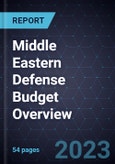Incremental Spending and Modernization Efforts Pave the Way for Market Growth
The Middle Eastern defense market is constantly growing in light of significant regional geopolitical changes, military modernization efforts, and the Russo-Ukrainian War, accelerating demand for advanced weapon systems. Accordingly, the regional defense market is expected to grow at a higher rate than the global average, to more than 2.5% per annum, while global growth is about 2% per annum.
Regional growth accelerators are embodied in GCC countries' drastically increased investments in defense budgets in light of the multi-pronged Iranian threat emerging on the other side of the Persian Gulf. Thus, the need to secure shipping lanes and the stability of the oil trade, along with the growing fear of attacks by Iranian-backed terrorist organizations and Iran's nuclear ambitions, constitute a temporary imperative for GCC members to demonstrate advanced military capabilities and deter aggression.
In the business sphere, the market has experienced significant upheaval with the entry of new local companies into the market, such as giant defense OEMs in Saudi Arabia and the UAE, alongside the continued traditional Israeli dominance in these markets, which has intensified in the era following the Abraham Accords and the potential for normalization with Saudi Arabia. These changes directly affect the culture and business environment in the region, alongside regulatory changes and localization, and offset emerging new requirements by local participants.
This study seeks to review market trends in depth, point out restraints and accelerators to market growth, extensively present key deals and business cooperation between various defense corporations in the region, and review the defense budgets of the leading countries (2023-2025), alongside a thorough analysis of defense strategy, local business environment, and competitive landscape.
The study also points out key growth drivers, including digitalization, modernization, localization trends, and regional strategic changes that could affect the market map in the coming years. All this is presented alongside an analysis of emerging business models, changing needs, and extensive technological changes across various core military domains.








